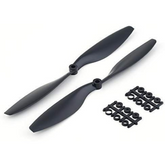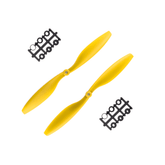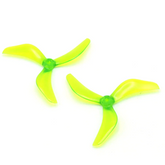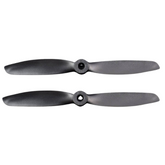Drone Propeller Balancing Techniques
Summary
Discover the key to optimal drone performance in our latest blog, "Drone Propeller Balancing Techniques." Uncover the importance of balanced propellers and delve into the realms of static and dynamic balancing methods. Learn how these techniques impact flight stability and longevity. We explore the frequency at which propellers should be balanced for peak efficiency. Elevate your drone experience with this insightful guide. Don't miss out—unlock the secrets to smoother flights and extended drone life. Read more now for a sky-high adventure!
Introduction
Drones have become an increasingly popular technology in recent years, and understanding the importance of effective propeller balancing is essential for professionals to take their drone operations to the next level. In order to maximize performance, a balanced set of rotors is vital as this allows them both spin efficiently with minimal noise or vibration levels.
This ensures smooth flight during operation which prevents any potential damage due to turbulence. Additionally, it can also extend battery life by reducing energy expenditure from maintaining balance while airborne. Properly balanced drones provide pilots with maximum control capabilities making it easier for more intricate aerial maneuvers than what could be achieved otherwise when unbalanced props cause uncontrolled pitch and yaw issues mid-flight leading to hazardous situations on multiple occasions if not addressed immediately upon installation.

Why balanced propellers are crucial for drone performance
Balanced propellers are absolutely necessary for drones to perform optimally. Unbalanced props can cause major issues like vibrations which decrease the efficiency of thrust and power, while also affecting flight stability and control responsiveness. On top of this, they might be able to cause damage to other components due to increased noise and vibration levels that come from unbalanced alternating forces produced by an unbalanced prop setup.
Quality balanced propellers will ensure all these problems don't occur, making sure your drone flies smoothly with a stable center gravity point allowing it to achieve greater speeds throughout its flights without severe impacts on battery life or engine performance life expectancy. Professional pilots understand how important good quality balancing is in order for their commercial operations to not only succeed but remain safe as well. Investing in high-grade professional balance tools ensures you have the best-performing drone structure possible!
What is static propeller balancing?
Static propeller balancing is a process of adjusting the static balance of an aircraft's propellers to make them run with less vibration and improved efficiency. This type of balancing helps reduce maintenance costs, improves safety, reduces cabin noise levels, and ultimately prolongs engine life.

The procedure begins by attaching sensors at various points around each blade in order to detect any imbalance in their distribution along its entire length or chord line. With this data collected from all blades at both low-speed conditions as well as high-speed flight profiles - it can be used for measuring how much weight needs to be added/subtracted from which particular location(s) on said blade’s chord line so that aerodynamic forces are equalized across the cross-sectional area at every rotational position during rotation (as opposed to just two opposite positions). In addition – these changes must also take into account other transient factors such as airframe flexibility & fuel burn/density restrictions when adding mass; thus ensuring smooth operation within optimal parameters over time while minimizing possible damage caused by unnecessary vibrations.
Finally – once completed correctly through multiple iterations - not only will you see smoother operations but also better performance because more power is now being put towards forward motion rather than overcoming turbulence & expelled energy due to imbalances created earlier on.
Advantages of static propeller balancing for drone
The advantages of static propeller balancing for drone enthusiasts are many, and here’s why:
- Increased Efficiency - Balancing props helps drones fly faster while using less energy. This means longer flight times with better performance and more precise manoeuvring.
- Improved Stability – Propellers that are balanced have a greater ability to counteract any turbulence in the air, reducing drift caused by vibration or uneven thrust from each prop making flights smoother overall.
- Reduced Noise Levels– When propellers aren't properly balanced they can create lots of noise during operation which affects not only the user but also anyone nearby who might be trying to shoot video footage or take photographs without interference from your own device's sound levels! By ensuring consistent weight distribution across all four blades constant noise will effectively be eliminated creating an environment free from distraction when capturing aerial content.
- Safer Flights- Properly weighted and evenly spinning blades help ensure optimal control over your craft; offering superior lift-off speed as well as increased stability throughout manoeuvres like turns or emergency stops allowing you to complete even complex tasks safely where otherwise would normally fail due to vibrations causing erratic behaviour in flight controls resulting straining motor components leading into potentially damaging moments if left unchecked regularly.
Dynamic propeller Balancing Techniques
Dynamic propeller balancing is a technique used in the aviation industry to ensure smooth and safe operation. The process involves measuring rotational forces created by the spinning of aircraft propellers, correcting any imbalances between them to reduce vibrations that could otherwise cause fatigue on engine components or even structural damage over time.

The goal with dynamic propeller balancing is to obtain optimum performance from each individual rotor blade during all phases of flight—from takeoff through cruise and descent while accounting for changing air loads as they move clockwise around their axial rotation point. This creates opposing pressure waves across both sides of an engine's blades, which results in more efficient airflow leading to increased fuel efficiency and reduced vibration levels at higher altitudes when compared to regular static-balanced props found in most single/twin piston airplanes today. Dynamic prop balancers measure these subtle differences using sophisticated tools such as accelerometers placed near each blade tip or strain gauges attached directly onto its surface – then adjust accordingly based upon pre-determined criteria like maximum runout velocity relative distance travelled per revs rpm (rotations), weight bias along span chords etc.
How Often Should You Balance Drone Propellers?
Properly balancing drone propellers is essential for ensuring a safe and successful flight. To ensure peak performance, it’s important to balance your props on a regular basis. How often you need to do this depends largely on the type of flying you are doing - if engaging in high-intensity or extreme stunts, then weekly maintenance should be done; more casual pilots might find monthly checks suffice. Check wear indicators regularly – small scratches can weaken components over time so proper monitoring is key! As such, scheduling some preventive downtime into your usual routine will help prolong the life of your equipment while improving its efficiency during flights.
How balanced propellers can extend the life of your drone
Balanced propellers can significantly extend the life of your drone. Whether you are using a commercial or hobby-grade model, having an optimal set of balanced props will help to reduce vibration and improve the overall performance and efficiency of your quadcopter. Balanced props will ensure that each rotation is smooth without any unnecessary force on other parts such as the battery, motor mountings etc., thereby preserving their condition for longer periods. Additionally, they also aid in better quality photos/videos due to reduced vibrations present during aerial filming sessions which result in sharper visuals with more accurate colours too!
In order to keep our drones running well over time it’s essential we maintain good maintenance practices like regularly balancing our prop sets before flying; this helps avoid potential problems later down the line making sure all flights remain safe and efficient while further extending their lifespan too – not only do balanced propellers benefit us but it benefits everyone else around us who may be potentially nearby risk when taking off into flight mode.
Conclusion
In conclusion, mastering drone propeller balancing is paramount for optimizing performance and ensuring a smooth flight experience. From understanding the significance of balanced propellers to delving into static and dynamic balancing techniques, we've explored the intricacies of this crucial aspect. Regular maintenance, as highlighted in our discussion on how often to balance drone propellers, is key. As you embark on your drone piloting journey, remember that balanced propellers are not just a preference but a necessity for efficiency and longevity. Elevate your drone experience – keep those propellers in perfect harmony for the ultimate aerial adventure! Ready to soar? Click for more drone mastery tips!
Frequently Asked Questions
1. How do you balance a drone propeller?
Maintaining a well-balanced drone propeller is essential for optimal flight performance and safety. Balancing a drone propeller requires precision and careful attention to detail. Firstly, it's crucial to inspect each individual blade for any damage or cracks before installation. Next, use a quality balancer tool specifically designed for drones to ensure proper weight distribution among all blades. Additionally, adjusting the angle of attack on each blade can also help achieve balance by fine-tuning lift and drag forces during flight. Regularly checking and rebalancing your drone's propellers will not only extend its lifespan but also enhance its overall maneuverability while capturing breathtaking aerial footage.
2. What is propeller balancing method?
Propeller balancing method is a crucial process that ensures the stability and efficiency of any propeller-driven machinery. This technique involves measuring and adjusting the weight distribution in each blade of a propeller to reduce vibrations, minimize wear and tear on components, improve performance, and increase safety levels. We understand how vital it is for businesses operating heavy-duty equipment such as airplanes or ships to have their propellers balanced regularly by professionals using advanced technology like computerized dynamic balancing systems. Ignoring proper balance can result in costly damages and potential hazards that can be easily avoided through regular maintenance using effective methods like this one.
3. How would you know if the propeller is out of balance?
When it comes to knowing if a propeller is out of balance, there are certain indicators that can help identify this issue. These include vibrations and abnormal sounds coming from the aircraft during takeoff or while in flight. Additionally, sudden changes in fuel consumption and performance can also be signs of an unbalanced propeller. It is crucial for pilots and maintenance personnel to conduct regular inspections and dynamic balancing procedures to ensure safe operation of the aircraft and prevent any potential damage caused by an imbalanced propeller.
4. Why is propeller balancing important in drones?
Propeller balancing is crucial for ensuring stable flight and optimal performance in drones. An unbalanced propeller can cause vibrations, which can lead to wear and tear on motors and electronics. This balance helps maintain efficient lift, improve battery life, and enhance overall flight safety, making it a key factor for drone enthusiasts and professionals alike.
5. How does imbalance affect drone flight?
An imbalanced propeller creates vibrations that disrupt the drone’s stability and control. This can lead to erratic flight patterns, higher power consumption, and increased wear on components. In severe cases, it may even cause crashes. Therefore, ensuring propeller balance is vital for safe and smooth drone operation.
6. What tools are used for balancing props?
Common tools for balancing propellers include propeller balancers, vibration analyzers, and digital scales. A simple two-point balancer allows you to see weight discrepancies easily. For precision, you may also use a multi-axis vibration sensor. These tools help identify and correct imbalances, ensuring smooth and stable flight.
7. How to identify an unbalanced propeller?
You can identify an unbalanced propeller by observing vibrations during flight or using a propeller balancer. A simple test involves placing the propeller on the balancer; if it tilts to one side, it’s unbalanced. Regularly inspecting your props for signs of wear or damage can also help indicate imbalance issues.
8. Can software detect prop imbalance?
Yes, specialized software can detect prop imbalance indirectly by analyzing flight data, such as vibrations and motor efficiency. While it won't pinpoint the exact imbalance, it can indicate irregularities in performance. Using this data, you can take corrective action to ensure stable and safe drone flight.
9. How to manually balance propellers?
To manually balance propellers, use a propeller balancer to identify heavy spots. Add or remove material, like tape, to achieve balance. Start by running tests to ensure even surface weight distribution. Regular checking and balancing will lead to smoother flights and increase the longevity of your drone's components.
10. What causes propeller imbalance?
Propeller imbalance can arise from manufacturing defects, damage from crashes, or uneven wear over time. Environmental factors like debris or dirt accumulation can also affect balance. Additionally, variations in material density during production can lead to discrepancies, causing imbalances that impact drone performance.
11. How often should I check prop balance?
You should check propeller balance before each major flight, especially after crashes or hard landings. Regular checks help identify any issues due to wear or damage. For best performance and safety, incorporating balance checks into your pre-flight routine is highly recommended.
12. Can damaged props be rebalanced?
While you can attempt to rebalance lightly damaged props, it's often safer to replace them. Significant damage may compromise structural integrity, leading to potential failure during flight. Always assess the damage carefully; if it’s extensive, getting a new propeller is the better option for safety and performance.
13. What’s the best prop material for stability?
Carbon fiber is widely considered the best material for prop stability due to its stiffness and low weight. This material offers excellent durability and can withstand stress better than plastic or wood. However, well-manufactured plastic props can also be stable and cost-effective for beginners and casual flyers.
1. How do you balance a drone propeller?
Maintaining a well-balanced drone propeller is essential for optimal flight performance and safety. Balancing a drone propeller requires precision and careful attention to detail. Firstly, it's crucial to inspect each individual blade for any damage or cracks before installation. Next, use a quality balancer tool specifically designed for drones to ensure proper weight distribution among all blades. Additionally, adjusting the angle of attack on each blade can also help achieve balance by fine-tuning lift and drag forces during flight. Regularly checking and rebalancing your drone's propellers will not only extend its lifespan but also enhance its overall maneuverability while capturing breathtaking aerial footage.
2. What is propeller balancing method?
Propeller balancing method is a crucial process that ensures the stability and efficiency of any propeller-driven machinery. This technique involves measuring and adjusting the weight distribution in each blade of a propeller to reduce vibrations, minimize wear and tear on components, improve performance, and increase safety levels. We understand how vital it is for businesses operating heavy-duty equipment such as airplanes or ships to have their propellers balanced regularly by professionals using advanced technology like computerized dynamic balancing systems. Ignoring proper balance can result in costly damages and potential hazards that can be easily avoided through regular maintenance using effective methods like this one.
3. How would you know if the propeller is out of balance?
When it comes to knowing if a propeller is out of balance, there are certain indicators that can help identify this issue. These include vibrations and abnormal sounds coming from the aircraft during takeoff or while in flight. Additionally, sudden changes in fuel consumption and performance can also be signs of an unbalanced propeller. It is crucial for pilots and maintenance personnel to conduct regular inspections and dynamic balancing procedures to ensure safe operation of the aircraft and prevent any potential damage caused by an imbalanced propeller.
4. Why is propeller balancing important in drones?
Propeller balancing is crucial for ensuring stable flight and optimal performance in drones. An unbalanced propeller can cause vibrations, which can lead to wear and tear on motors and electronics. This balance helps maintain efficient lift, improve battery life, and enhance overall flight safety, making it a key factor for drone enthusiasts and professionals alike.
5. How does imbalance affect drone flight?
An imbalanced propeller creates vibrations that disrupt the drone’s stability and control. This can lead to erratic flight patterns, higher power consumption, and increased wear on components. In severe cases, it may even cause crashes. Therefore, ensuring propeller balance is vital for safe and smooth drone operation.
6. What tools are used for balancing props?
Common tools for balancing propellers include propeller balancers, vibration analyzers, and digital scales. A simple two-point balancer allows you to see weight discrepancies easily. For precision, you may also use a multi-axis vibration sensor. These tools help identify and correct imbalances, ensuring smooth and stable flight.
7. How to identify an unbalanced propeller?
You can identify an unbalanced propeller by observing vibrations during flight or using a propeller balancer. A simple test involves placing the propeller on the balancer; if it tilts to one side, it’s unbalanced. Regularly inspecting your props for signs of wear or damage can also help indicate imbalance issues.
8. Can software detect prop imbalance?
Yes, specialized software can detect prop imbalance indirectly by analyzing flight data, such as vibrations and motor efficiency. While it won't pinpoint the exact imbalance, it can indicate irregularities in performance. Using this data, you can take corrective action to ensure stable and safe drone flight.
9. How to manually balance propellers?
To manually balance propellers, use a propeller balancer to identify heavy spots. Add or remove material, like tape, to achieve balance. Start by running tests to ensure even surface weight distribution. Regular checking and balancing will lead to smoother flights and increase the longevity of your drone's components.
10. What causes propeller imbalance?
Propeller imbalance can arise from manufacturing defects, damage from crashes, or uneven wear over time. Environmental factors like debris or dirt accumulation can also affect balance. Additionally, variations in material density during production can lead to discrepancies, causing imbalances that impact drone performance.
11. How often should I check prop balance?
You should check propeller balance before each major flight, especially after crashes or hard landings. Regular checks help identify any issues due to wear or damage. For best performance and safety, incorporating balance checks into your pre-flight routine is highly recommended.
12. Can damaged props be rebalanced?
While you can attempt to rebalance lightly damaged props, it's often safer to replace them. Significant damage may compromise structural integrity, leading to potential failure during flight. Always assess the damage carefully; if it’s extensive, getting a new propeller is the better option for safety and performance.
13. What’s the best prop material for stability?
Carbon fiber is widely considered the best material for prop stability due to its stiffness and low weight. This material offers excellent durability and can withstand stress better than plastic or wood. However, well-manufactured plastic props can also be stable and cost-effective for beginners and casual flyers.












